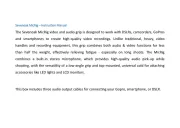Sevenoak SK-GH01 Manual
Sevenoak
Kamerastativ
SK-GH01
| Mærke: | Sevenoak |
| Kategori: | Kamerastativ |
| Model: | SK-GH01 |
| Højde: | 235 mm |
| Vægt: | 1400 g |
| Produktfarve: | Sort |
| Maksimal vægtkapacitet: | - kg |
| Indbygget vaterpas: | Ingen |
| Trefods-hovedtype: | Kardanled |
| Vedhæftelse: | 3/8 " |
Har du brug for hjælp?
Hvis du har brug for hjælp til Sevenoak SK-GH01 stil et spørgsmål nedenfor, og andre brugere vil svare dig
Kamerastativ Sevenoak Manualer

6 September 2025

19 Juni 2024

19 Juni 2024

19 Juni 2024

18 Juni 2024

18 Juni 2024

18 Juni 2024

18 Juni 2024
Kamerastativ Manualer
- Bee Star
- Magnus
- Vello
- 3 Legged Thing
- Rolls
- Sachtler
- LanParte
- Ghost
- Savage
- Rollei
- CamLink
- Essentiel B
- Geekoto
- Vonyx
- Celestron
Nyeste Kamerastativ Manualer

8 December 2025

6 December 2025

5 December 2025

1 December 2025

1 December 2025

29 November 2025

29 November 2025

28 November 2025

28 November 2025

25 November 2025
